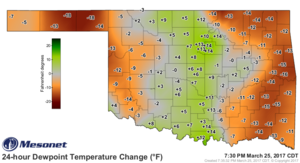After perusing the 12 UTC NAM and GFS forecasts, there are a few primary differences that I've noticed. I much more like the GFS 18-00 UTC forecast, as it has a much stronger lower level wind field than the NAM, which seems to be nearly doubling the 0-3 km SRH at 21 UTC in southern Oklahoma. Deep layer shear looks good in both forecasts and there is sufficient CAPE (>1000 J/kg MLCAPE) in southern Oklahoma. In addition, at 21 UTC the GFS at Purcell, OK has stronger lift throughout the column (see first image), which has the benefit of eroding the capping inversion by 21 UTC. This is related to the fact that the GFS solution has precipitation break out at 21 UTC, where as the NAM has the precipitation holding off till 3 UTC. Although I should add that the NAM doesn't have any sufficient moistening in the mid levels after 21 UTC, which needed to activate the BMJ convective parameterization.
Pairing forecast soundings from ahead and behind the dry line from the GFS and NAM forecasts suggest that the dry line circulation will be sufficiently deep enough to get parcels ahead of the dry line past their MLLFCs, which is a very good thing if we are questioning the possibility of convection initiation. From this, I am optimistic that storms will develop, but the issues of NWP recently under-doing the mixing Tim Supinie has brought up here and on Twitter constantly nag me and push me to adjust the NWP low-level moisture forecasts to be drier. However, right now I can see 1-2 supercells developing from this setup in southern OK/northern TX, at least from the GFS forecast. In particular, the Ardmore, OK 21-00 UTC GFS forecast soundings look incredible. Now, if the surface dew point drops below 55 F tomorrow, I will be very worried about whether or not storms will actually develop and sustain themselves. I can be a little pessimistic about the moisture quality, but right now I'm feeling cautiously optimistic about tomorrow.
One thing that does stand out is that the NAM at 16-18 UTC has an odd moisture profile (with rapid moistening and drying with height near 850 mb in second image, although the 17 UTC sounding looks better) near the top of the boundary layer that stands out to me as suspicious. My guess is that this must be due to some of the parameterizations in the NAM, and given how unrealistic the profile is (I've never seen something like that in nature), I suspect that the NAM's moisture evolution may be highly dependent upon the parameterization schemes.
P.S. With respect to the NCAR ensemble run, I wouldn't pay too much attention to it, as most if not all of the members have already busted the 18 UTC 2-m dewpoint temperature in southern Texas by nearly 10-20 F, and suggests that any moisture advected from that area northwards during the day or tomorrow will be drier than reality. Per other forecasts, the moisture in southern Texas plays a critical role in moistening up the southern Oklahoma/northern Texas areas as it gets advected northwards by the low-level jet stream. Another thing noted by Tim Supinie (who I've been discussing the forecast with for the past few hours) is that the 2-m dewpoint at Brownsville is running above the mean of 9 UTC SREF forecasts. This may also suggest that the 9 UTC SREF members may be also under-doing how moist the source region is for our moisture.
View attachment 15348
View attachment 15349











